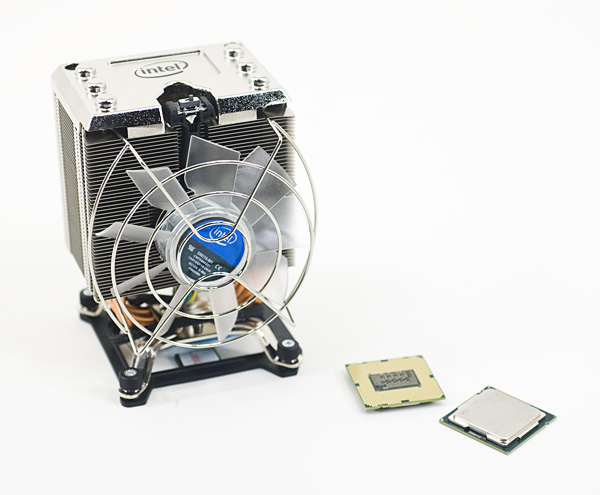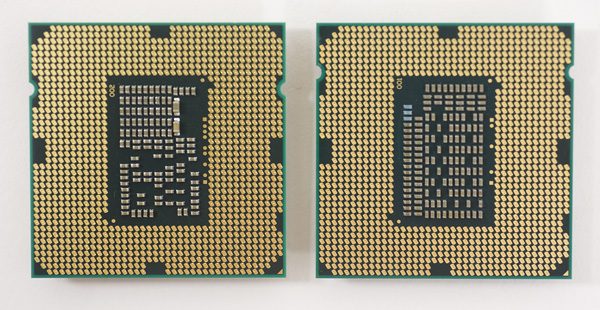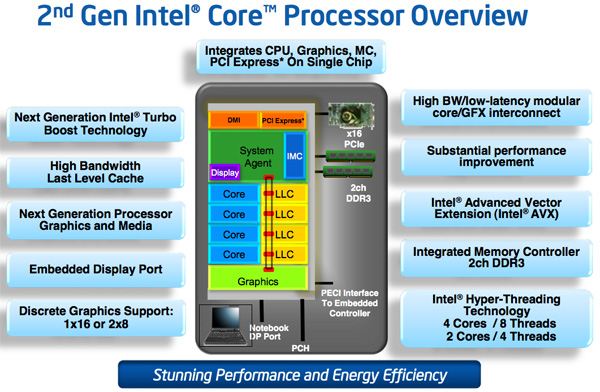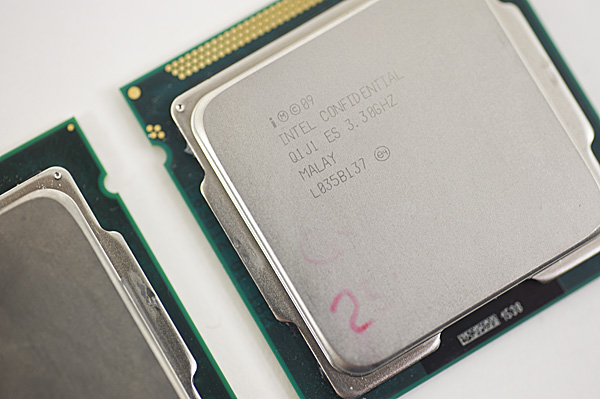The Sandy Bridge Review: Intel Core i7-2600K, i5-2500K and Core i3-2100 Tested
by Anand Lal Shimpi on January 3, 2011 12:01 AM ESTIntel never quite reached 4GHz with the Pentium 4. Despite being on a dedicated quest for gigahertz the company stopped short and the best we ever got was 3.8GHz. Within a year the clock (no pun intended) was reset and we were all running Core 2 Duos at under 3GHz. With each subsequent generation Intel inched those clock speeds higher, but preferred to gain performance through efficiency rather than frequency.
Today, Intel quietly finishes what it started nearly a decade ago. When running a single threaded application, the Core i7-2600K will power gate three of its four cores and turbo the fourth core as high as 3.8GHz. Even with two cores active, the 32nm chip can run them both up to 3.7GHz. The only thing keeping us from 4GHz is a lack of competition to be honest. Relying on single-click motherboard auto-overclocking alone, the 2600K is easily at 4.4GHz. For those of you who want more, 4.6-4.8GHz is within reason. All on air, without any exotic cooling.
Unlike Lynnfield, Sandy Bridge isn’t just about turbo (although Sandy Bridge’s turbo modes are quite awesome). Architecturally it’s the biggest change we’ve seen since Conroe, although looking at a high level block diagram you wouldn’t be able to tell. Architecture width hasn’t changed, but internally SNB features a complete redesign of the Out of Order execution engine, a more efficient front end (courtesy of the decoded µop cache) and a very high bandwidth ring bus. The L3 cache is also lower and the memory controller is much faster. I’ve gone through the architectural improvements in detail here. The end result is better performance all around. For the same money as you would’ve spent last year, you can expect anywhere from 10-50% more performance in existing applications and games from Sandy Bridge.
I mentioned Lynnfield because the performance mainstream quad-core segment hasn’t seen an update from Intel since its introduction in 2009. Sandy Bridge is here to fix that. The architecture will be available, at least initially, in both dual and quad-core flavors for mobile and desktop (our full look at mobile Sandy Bridge is here). By the end of the year we’ll have a six core version as well for the high-end desktop market, not to mention countless Xeon branded SKUs for servers.
The quad-core desktop Sandy Bridge die clocks in at 995 million transistors. We’ll have to wait for Ivy Bridge to break a billion in the mainstream. Encompassed within that transistor count are 114 million transistors dedicated to what Intel now calls Processor Graphics. Internally it’s referred to as the Gen 6.0 Processor Graphics Controller or GT for short. This is a DX10 graphics core that shares little in common with its predecessor. Like the SNB CPU architecture, the GT core architecture has been revamped and optimized to increase IPC. As we mentioned in our Sandy Bridge Preview article, Intel’s new integrated graphics is enough to make $40-$50 discrete GPUs redundant. For the first time since the i740, Intel is taking 3D graphics performance seriously.
| CPU Specification Comparison | ||||||||
| CPU | Manufacturing Process | Cores | Transistor Count | Die Size | ||||
| AMD Thuban 6C | 45nm | 6 | 904M | 346mm2 | ||||
| AMD Deneb 4C | 45nm | 4 | 758M | 258mm2 | ||||
| Intel Gulftown 6C | 32nm | 6 | 1.17B | 240mm2 | ||||
| Intel Nehalem/Bloomfield 4C | 45nm | 4 | 731M | 263mm2 | ||||
| Intel Sandy Bridge 4C | 32nm | 4 | 995M | 216mm2 | ||||
| Intel Lynnfield 4C | 45nm | 4 | 774M | 296mm2 | ||||
| Intel Clarkdale 2C | 32nm | 2 | 384M | 81mm2 | ||||
| Intel Sandy Bridge 2C (GT1) | 32nm | 2 | 504M | 131mm2 | ||||
| Intel Sandy Bridge 2C (GT2) | 32nm | 2 | 624M | 149mm2 | ||||
It’s not all about hardware either. Game testing and driver validation actually has real money behind it at Intel. We’ll see how this progresses over time, but graphics at Intel today very different than it has ever been.
Despite the heavy spending on an on-die GPU, the focus of Sandy Bridge is still improving CPU performance: each core requires 55 million transistors. A complete quad-core Sandy Bridge die measures 216mm2, only 2mm2 larger than the old Core 2 Quad 9000 series (but much, much faster).
As a concession to advancements in GPU computing rather than build SNB’s GPU into a general purpose compute monster Intel outfitted the chip with a small amount of fixed function hardware to enable hardware video transcoding. The marketing folks at Intel call this Quick Sync technology. And for the first time I’ll say that the marketing name doesn’t do the technology justice: Quick Sync puts all previous attempts at GPU accelerated video transcoding to shame. It’s that fast.
There’s also the overclocking controversy. Sandy Bridge is all about integration and thus the clock generator has been moved off of the motherboard and on to the chipset, where its frequency is almost completely locked. BCLK overclocking is dead. Thankfully for some of the chips we care about, Intel will offer fully unlocked versions for the enthusiast community. And these are likely the ones you’ll want to buy. Here’s a preview of what’s to come:
The lower end chips are fully locked. We had difficulty recommending most of the Clarkdale lineup and I wouldn’t be surprised if we have that same problem going forward at the very low-end of the SNB family. AMD will be free to compete for marketshare down there just as it is today.
With the CPU comes a new platform as well. In order to maintain its healthy profit margins Intel breaks backwards compatibility (and thus avoids validation) with existing LGA-1156 motherboards, Sandy Bridge requires a new LGA-1155 motherboard equipped with a 6-series chipset. You can re-use your old heatsinks however.

Clarkdale (left) vs. Sandy Bridge (right)
The new chipset brings 6Gbps SATA support (2 ports) but still no native USB 3.0. That’ll be a 2012 thing it seems.













283 Comments
View All Comments
samrty22331 - Wednesday, June 1, 2011 - link
visual studio 2010 professional not supported intel i5 2500kso
can you say
how to install vs 2010 in this
Okurka - Saturday, August 13, 2011 - link
The base clock of the HD 3000 GPU is 1100 MHz, not 850 MHz.That makes the 1550 MHz an overclock of 40,9 %, not 82,4 % as stated in the article.
khalnayak - Sunday, January 22, 2012 - link
I am having Intel HD 3000 - Sandy Bridge in my system and i was willing to get the game called "oil rush" but then i have found weird response for the game here http://www.futurehardware.com/pc-gaming/288.htm , so i just wanted to know is there any one who have tested the Intel HD 3000 - Sandy Bridge for oil rush, any help for this will be highly appreciated.thr0nez101 - Sunday, January 29, 2012 - link
I've got intel hd graphics 3000 and according to this forum/review it has a prob running dawn of war 2 on low graphics... i have it set to max graphics and i runs a dream... same with a lot of games i play on it...oliverr - Saturday, February 11, 2012 - link
guys, is it safe to overclock the Intel HD 3000 GPU ? I own a 2500K CPU. I can overclock the GPU to 1450mhz and it looks stable . But i dont know how to read the temperature from the GPU unit, so iam afraid i could burn my GPU/CPU .cerberaspeed12 - Thursday, February 16, 2012 - link
hi.first off all sorry for my english.I have a doubt .I have seen the dells lap top.they are identical but one have the Intel Core i3-2350M 2.3GHz ,the odher is Intel Core i5-2450M 2.5GHz , and the third have Intel Core i7 -2670M 2.4GH
the prices is 600 $,670$ and 800 $,I am working some live multi channel audio production and .net teh programing.So for wich one i soud go.Thanks
indyaah - Tuesday, February 21, 2012 - link
any suggestions how can i??weirdo2989 - Sunday, March 4, 2012 - link
Hi Techies,I recently got this processor. It is ultimate for gaming.
However in my windows CPU meter gadget, i can see only 2 cores functioning. Stock comes with unlocked multiplier afaik. But here in my system, it shows only 2 cores. Is there any way to activate all the cores for better performance?
Any suggestions/tips would be highly appreciated.
Thanks.
Regards,
Parth
0121birmingham - Saturday, May 12, 2012 - link
Just to say i wrote a small post on this issue at http://intel23976fpsproblem.blogspot.co.uk/It does not look like the problem has been fixed in the new z77 line up. DAM
milutzuk - Saturday, July 14, 2012 - link
Beside VS2008 compiler performance I would like to see growing a database with some Java compiler performance, either under NetBeans or Eclipse. Thank you.